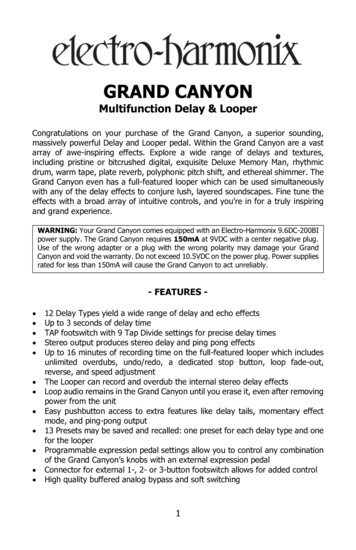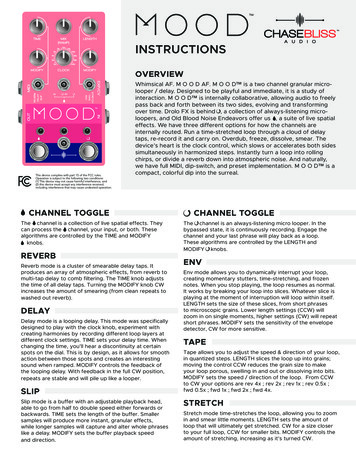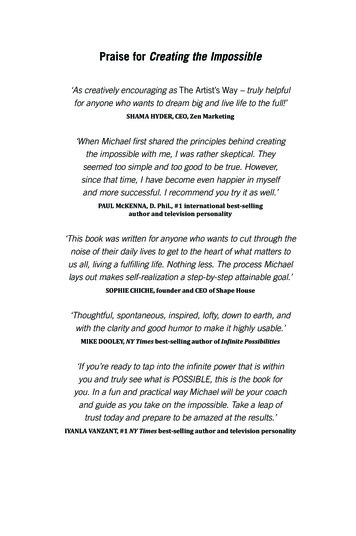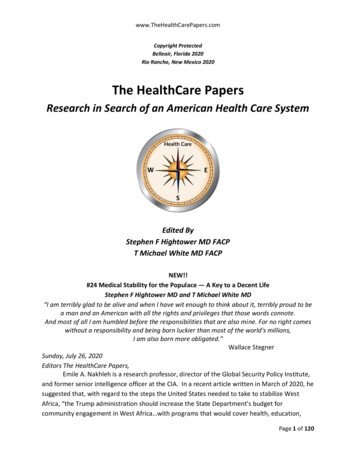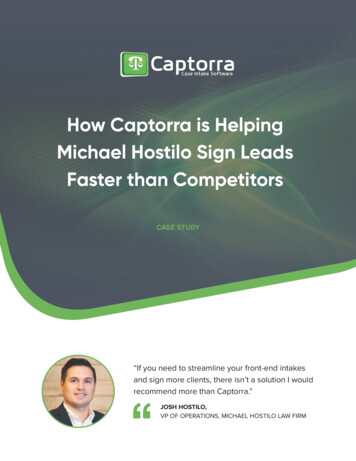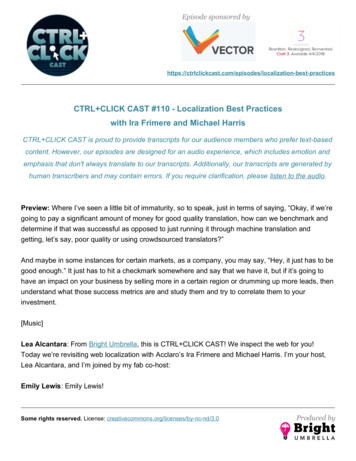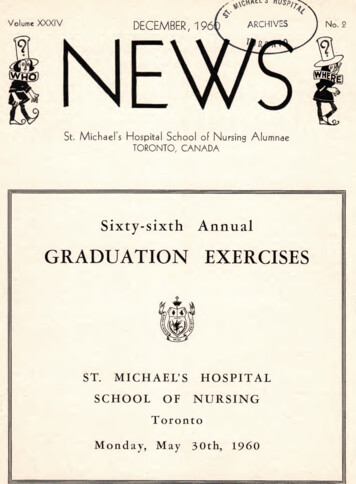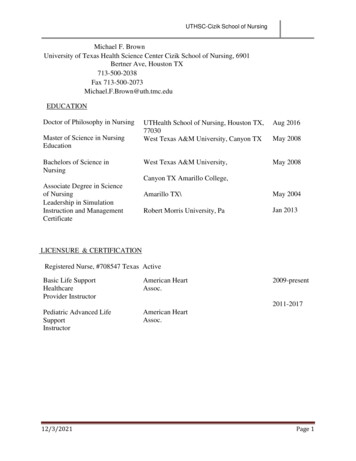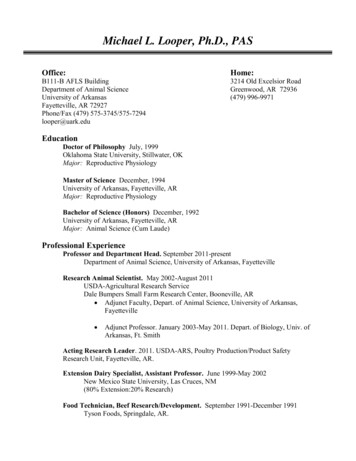
Transcription
Michael L. Looper, Ph.D., PASOffice:B111-B AFLS BuildingDepartment of Animal ScienceUniversity of ArkansasFayetteville, AR 72927Phone/Fax (479) 575-3745/575-7294looper@uark.eduHome:3214 Old Excelsior RoadGreenwood, AR 72936(479) 996-9971EducationDoctor of Philosophy July, 1999Oklahoma State University, Stillwater, OKMajor: Reproductive PhysiologyMaster of Science December, 1994University of Arkansas, Fayetteville, ARMajor: Reproductive PhysiologyBachelor of Science (Honors) December, 1992University of Arkansas, Fayetteville, ARMajor: Animal Science (Cum Laude)Professional ExperienceProfessor and Department Head. September 2011-presentDepartment of Animal Science, University of Arkansas, FayettevilleResearch Animal Scientist. May 2002-August 2011USDA-Agricultural Research ServiceDale Bumpers Small Farm Research Center, Booneville, AR Adjunct Faculty, Depart. of Animal Science, University of Arkansas,Fayetteville Adjunct Professor. January 2003-May 2011. Depart. of Biology, Univ. ofArkansas, Ft. SmithActing Research Leader. 2011. USDA-ARS, Poultry Production/Product SafetyResearch Unit, Fayetteville, AR.Extension Dairy Specialist, Assistant Professor. June 1999-May 2002New Mexico State University, Las Cruces, NM(80% Extension:20% Research)Food Technician, Beef Research/Development. September 1991-December 1991Tyson Foods, Springdale, AR.
M. L. Looper2Administrative accomplishmentsProfessor and Head of the Department of Animal Science at the University of Arkansas where Iam responsible for faculty recruitment and development, instructional program development anddelivery, coordination of departmental research and Extension programs, and evaluation ofpersonnel delivery of service programs. I represent the department's interest within and outside theUniversity and maintain relationships with students, administrators, University committees,alumni, professional organizations, and various other public and private groups. In partnershipwith the Division of Agriculture and Bumpers College, I develop the department's annual budgetrequest, and administer expenditure of the allocated funds and other resources available to thedepartment. I manage 23 faculty members, 24 salaried research staff, nine administrative staff(Fayetteville and Little Rock), five Livestock Market News Service reporters (Little Rock), and25-30 graduate students in three locations throughout the state (Fayetteville, Little Rock andHope). I am responsible for a budget of approximately 4.3 million ( 1.24 million M&O and 3.03 million for salaries).Below are specific accomplishments achieved since 2011 by faculty, staff, and I. Faculty hires - Since January 2015, the Department has hired seven faculty members;five in Fayetteville and two in Little Rock. We are in the process of advertising forthree additional faculty positions. Enhanced faculty and student diversity - The faculty has almost doubled in numberof female members (from 9 to 17% over the past five years); two non-Caucasian malefaculty members were recently hired. Coordinated and developed MOU betweenLincoln University (1890’s Institution) and Department for graduate student training– five students have completed or in the process of completing graduate degrees. Improved Departmental morale, transparency, and communication - I have alwaysmaintained an open-door policy. Improved camaraderie and communication hasresulted in greater cooperation and collaboration among the faculty. Integration of on- and off-campus faculty - Enhanced integration of off-campusfaculty with grant submissions, student committees, etc. On a regular basis, I make allefforts to travel to off-campus locations. Growth in graduate program; emphasis on Ph.D candidates - Increased M.S. (12.5%increase) and Ph.D. (38% increase) students from 2014 to 2015. Secured additionalassistantships for growth in graduate program. Implemented the Dr. Paul Noland(former faculty member and Head) Graduate Student Award for M.S. and Ph.D.Winners receive travel stipends to scientific meetings. Enhanced the undergraduate experience – Enrollment has increased 9.3% since2011; 16% of students are enrolled in the Honors College; established three areas ofstudy concentrations with the Animal Science curriculum: General Animal Science,Equine Science and Pre-Professional to provide students with more options;established a Horse Judging Team, Ranch Horse Team, and a Departmental
M. L. Looper3ambassador group (REPS); in the process of enhancing international experiences(recent specific efforts in Belgium, Panama, China, and Argentina). Increased research efforts - Renovation of laboratory space – Initiated and receivedpartial funding for up-grades to outdated laboratory space; research publications haveincreased over 300% for peer-reviewed journal articles in the last 4 years; enhancedcollaboration with increased funding (two additional MOUs) from USDA-ARSlocations in Booneville, AR; Lexington, KY; and Marshfield, WI. Increased awareness of Department - Established a departmental advisory committeeusing a wide-variety of industry stakeholders; hired a public relations person to developnewsletters, press releases, social media of Departmental activities to the College,University and stakeholders.Research accomplishmentsResearch collaboration has always been a strong component of my program where I have servedas project director, co-project director, or co-investigator on numerous collaborations within myunit, state, agency, as well as with national and international scientists. My publication record ofover 249 authored or coauthored publications [61 peer-refereed journal articles, 77 peer-refereedagriculture experiment station reports/conference proceedings, and 111 research abstracts(abstracts were removed to reduce length)] is evidence of my ability to conceive, plan, conduct,collaborate, and publish research results. I have funded a portion of my research program throughgrants totaling almost 800,000. I have advised or co-advised 20 graduate students in productionmanagement and reproductive physiology. I have been invited to present over 25 seminars onvarious livestock-related topics throughout the United States, China, and Argentina. I havepresented seminars and research papers at numerous regional, national, and international scientificforums. For my research efforts, I received the Outstanding Young Scientist-Research Award forthe Southern Section of the American Society of Animal Science, USDA/ARS, Herbert L.Rothbart Outstanding Early Career Research Scientist Award, and the Presidential Early CareerAward for Scientists and Engineers.PublicationsJournal Articles1) Looper, M. L., J. A. Vizcarra, and R. P. Wettemann. 2000. Estrous and luteal activity ofpostpartum beef cows after treatment with gonadotropin-releasing hormone and prostaglandinF2 . Prof. Anim. Sci. 16:207-212.2) Brown, A. H., Jr., C. F. Rosenkrans, Jr., Z. B. Johnson, M. L. Looper, B. A. Sandelin, and E.L. Oxford. 2000. Heritability of lactate dehydrogenase activity in replacement beef heifers.Doklady Vsesoyuzoni Akademii Sel's Kokhozyaistvennykh Nauk Im. Rep. Russian Acad.Agric. Sci. 6:40-42.3) Lents, C. A., R. P. Wettemann, M. J. Paape, J. A. Vizcarra, M. L. Looper, D. S. Buchanan, andK. S. Lusby. 2002. Efficacy of intramuscular treatment of beef cows with oxytetracycline toreduce mastitis and to increase calf growth. J. Anim. Sci. 80:1405-1412.
M. L. Looper44) Looper, M. L., C. F. Rosenkrans, Jr., Z. B. Johnson, A. H. Brown, Jr., J. A. Hornsby, and J. L.Perkins. 2002. Relationships among growth characteristics of replacement Angus heifers.Prof. Anim. Sci. 18:120-126.5) White, F. J., R. P. Wettemann, M. L. Looper, T. M. Prado, and G. L. Morgan. 2002. Seasonaleffects on estrous behavior and time of ovulation in beef cows. J. Anim. Sci. 80:3053-3059.6) Looper, M. L., J. A. Vizcarra, R. P. Wettemann, J. R. Malayer, T. D. Braden, R.D. Geisert,and G. L. Morgan. 2003. Influence of estradiol, progesterone, and nutrition on concentrationsof gonadotropins and GnRH receptors, and gene expression for GnRH receptors andgonadotropin subunits in pituitaries of beef cows. J. Anim. Sci. 81:269-278.7) Rogers, C. A, T. W. Drummond, R. Flores, C. P. Mathis, and M. L. Looper. 2003. Case Study:Estrous characteristics and pregnancy rates of beef heifers administered two synchronizationprotocols. Prof. Anim. Sci. 19:19-22.8) Looper, M. L., C. A. Lents, and R. P. Wettemann. 2003. Body condition at parturition andpostpartum weight changes do not influence the incidence of short-lived corpora lutea inpostpartum beef cows. J. Anim. Sci. 81:2390-2394.9) Fitzgerald, A. C., T. S. Edrington, M. L. Looper, T. R. Callaway, K. J. Genovese, K. M.Bischoff, J. L. McReynolds, J. D. Thomas, R. C. Anderson, and D. J. Nisbet. 2003.Antimicrobial susceptibility and factors affecting the shedding of Escherichia coli O157:H7and Salmonella in dairy cattle. Lett. Appl. Micro. 37:392-398.10) Fitzgerald, A. C., and M. L. Looper. 2003. Non-antibiotic treatment of postpartum dairy cowswith fever and metabolic disorders. Prof. Anim. Sci. 19:429-434.11) Moore, D. A., J. H. Kirk, D. J. Klingborg, F. Garry, W. Wailes, J. Dalton, J. Busboom, M.Payne, J. Marchello, M. Poe, M. Looper, D. Falk, and T. Wright. 2004. DairyBeef:Maximizing quality and profits – a consistent food safety message. J. Dairy Sci. 87:183-190.12) Flores, R., M. L. Looper, D. M. Hallford, and M. G. Thomas. 2004. Influence of bovinesomatotropin on characteristics of estrus and reproduction of Holstein cows during summermonths. Prof. Anim. Sci. 20:191-197.13) Edrington, T. S., M. E. Hume, M. L. Looper, A. C. Fitzgerald, T. R. Callaway, K. J. Genovese,K. M. Bischoff, J. L. McReynolds, R. C. Anderson, and D. J. Nisbet. 2004. Variation in thefaecal shedding of Salmonella and E. coli 0157:H7 in lactating dairy cattle and examination ofSalmonella genotypes using pulsed field gel electrophoresis. Lett. Appl. Micro. 38:366-372.14) Rogers, C. A., A. C. Fitzgerald, M. A. Carr, B. R. Covey, J. D. Thomas, and M. L. Looper.2004. On-farm management decisions to improve beef quality of market dairy cows. J. DairySci. 87:1558-1564.15) Edrington, T. S., C. L. Schultz, K. M. Bischoff, T. R. Callaway, M. L. Looper, K. J. Genovese,Y. S. Jung, J. L. McReynolds, R. C. Anderson, and D. J. Nisbet. 2004. Antimicrobial
M. L. Looper5resistance and serotype prevalence of Salmonella isolated from dairy cattle in the SouthwesternUnited States. Microb. Drug Resist. 10:51-56.16) Aiken, G. E., F. M. Rouquette, and M. L. Looper. 2004. Prediction of future carcass traits instocker cattle at the conclusion of grazing. Prof. Anim. Sci. 20:246-254.17) Edrington, T. S., C. L. Schultz, K. J. Genovese, T. R. Callaway, M. L. Looper, K. M. Bischoff,J. L. McReynolds, R. C. Anderson, and D. J. Nisbet. 2004. Examination of heat stress andstage of lactation (early versus late) on fecal shedding of E. coli O157:H7 and Salmonella indairy cattle. Foodborne Path. Disease 1(2):114-119.18) Hume, M. E., T. S. Edrington, M. L. Looper, T. R. Callaway, K. J. Genovese, and D. J. Nisbet.2004. Salmonella genotype diversity in nonlactating and lactating dairy cows. J. Food. Prot.67(10):2280-2283.19) Aiken, G. E., S. F. Tabler, M. L. Looper, and D. K. Brauer. 2005. Supplementation withground corn is cost effective for increasing weight gain of steers grazing bermudagrass. Forag.Grazlnds. doi:10.1094/FG-2005-0210-01-RS.20) Looper, M. L., G. E. Aiken, R. Flores, and C. F. Rosenkrans, Jr. 2005. Influence of nutrientsupplementation on body weight and condition, and pregnancy of market beef cows grazingstockpiled and spring-growth tall fescue. Prof. Anim. Sci. 21:225-231.21) Looper, M. L., T. S. Edrington, R. Flores, C. F. Rosenkrans, Jr., M. E. Nihsen, and G. E. Aiken.2006. Prevalence of Escherichia coli O157:H7 and Salmonella in beef steers consumingdifferent forage diets. Lett. Appl. Micro. 42:583-588.22) Aiken, G. E., M. L. Looper, S. F. Tabler, D. K. Brauer, J. R. Strickland, and F. N. Schrick.2006. Influence of stocking rate and steroidal implants on growth rate of steers grazing toxictall fescue and subsequent physiological responses. J. Anim. Sci. 84:1626-1632.23) Looper, M. L., T. S. Edrington, R. Flores, C. F. Rosenkrans, Jr., and G. E. Aiken. 2006.Escherichia coli O157:H7 and Salmonella in water and soil from tall fescue paddocks.Foodborne Path. Dis. 3:203-208.24) Flores, R., M. L. Looper, D. L. Kreider, N. M. Post, and C. F. Rosenkrans, Jr. 2006. Estrousbehavior and initiation of estrous cycles in postpartum Brahman-influenced cows aftertreatment with progesterone and prostaglandin F2α. J. Anim. Sci. 84:1916-1925.25) Edrington, T. S., M. L. Looper, S. E. Duke, T. R. Callaway, K. J. Genovese, R. C. Anderson,and D. J. Nisbet. 2006. Effect of ionophore supplementation on the incidence of Escherichiacoli O157:H7 and Salmonella and antimicrobial susceptibility of fecal coliforms in stockercattle. Foodborne Path. Dis. 3:284-291.26) Edrington, T. S., T. R. Callaway, S. E. Ives, M. J. Engler, M. L. Looper, R. C. Anderson, andD. J. Nisbet. 2006. Seasonal shedding of Escherichia coli O157:H7 in ruminants: a newhypothesis. Foodborne Path. Dis. 3:413-421.
M. L. Looper627) Looper, M. L., T. S. Edrington, R. Flores, J. M. Burke, T. R. Callaway, G. E. Aiken, F. N.Schrick, and C. F. Rosenkrans, Jr. 2007. Influence of dietary endophyte-infected(Neotyphodium coenophialum) tall fescue (Festuca arundinacea) seed on fecal shedding ofantibiotic-resistance selected Escherichia coli O157:H7 in ewes. J. Anim. Sci. 85:1102-1108.28) Flores, R., M. L. Looper, R. W. Rorie, M. A. Lamb, S. T. Reiter, D. M. Hallford, D. L. Kreider,and C. F. Rosenkrans, Jr. 2007. Influence of body condition and bovine somatotropin onestrous behavior, reproductive performance, and concentrations of serum somatotropin andplasma fatty acids in postpartum Brahman-influenced cows. J. Anim. Sci. 85:1318-1329.29) Flores, R., W. K. Coblentz, R. K. Ogden, K. P. Coffey, M. L. Looper, C. P. West, and C. F.Rosenkrans, Jr. 2007. Effects of fescue type and sampling date on the ruminal disappearancekinetics of autumn-stockpiled tall fescue. J. Dairy Sci. 90:2883-2896.30) Aiken, G. E., B. H. Kirch, J. R. Strickland, L. P. Bush, M. L. Looper, and F. N. Schrick. 2007.Hemodynamic responses of the caudal artery to toxic tall fescue in beef heifers. J. Anim. Sci.85:2337-2345.31) Looper, M. L., T. P. Neidecker, Z. B. Johnson, and C. F. Rosenkrans, Jr. 2008. Relationshipof lactate dehydrogenase activity with body measurements of beef cows and calves. Prof.Anim. Sci. 24:60-66.32) Lents, C. A., R. P. Wettemann, M. J. Paape, M. L. Looper, and D. S. Buchanan. 2008. Effectsof dry cow treatment of beef cows on pathogenic organisms, milk somatic cell counts, andcalf growth during the subsequent lactation. J. Anim. Sci. 86:748-755.33) Flores, R., W. K. Coblentz, R. K. Ogden, K. P. Coffey, M. L. Looper, C. P. West, and C. F.Rosenkrans, Jr. 2008. Effects of fescue type and sampling date on the nitrogen disappearancekinetics of autumn-stockpiled tall fescue. J. Dairy Sci. 91:1597-1606.34) Callaway, T. R., T. S. Edrington, A. D. Brabban, R. C. Anderson, M. L. Rossman, M. J. Engler,K. J. Genovese, J. E. Keen, M. L. Looper, E. M. Kutter, and D. J. Nisbet. 2008. Bacteriophageisolated from feedlot cattle can reduce Escherichia coli O157:H7 populations in ruminantintestinal tracts. Foodborne Path. Dis. 5:183-191.35) Flores, R., M. L. Looper, R. W. Rorie, D. M. Hallford, and C. F. Rosenkrans, Jr. 2008.Endocrine factors and ovarian follicles are influenced by body condition and somatotropin inpostpartum beef cows. J. Anim. Sci. 86:1335-1344.36) Looper, M. L., T. S. Edrington, A. S. Moubarak, T. R. Callaway, and C. F. Rosenkrans, Jr.2008. Effects of the ergot alkaloids dihydroergotamine, ergonovine, and ergotamine on thegrowth of Escherichia coli O157:H7 in vitro. Foodborne Path. Dis. 5:599-604.37) Looper, M. L, R. W. Rorie, C. N. Person, T. D. Lester, D. M. Hallford, G. E. Aiken, C. A.Roberts, G. E. Rottinghaus, and C. F. Rosenkrans, Jr. 2009. Influence of toxic endophyteinfected fescue on sperm characteristics and endocrine factors of yearling Brahman-influencedbulls. J. Anim. Sci. 87:1184-1191.
M. L. Looper738) Caldwell, J. D., K. P. Coffey, W. K. Coblentz, J. A. Jennings, D. S. Hubbell, III, D. L. Kreider,M. L. Looper, and C. F. Rosenkrans, Jr. 2009. Performance by fall-calving cows grazing tallfescue pastures with different proportions stockpiled. Forag. Grazlnds. doi:10.1094/FG-20090312-01-RS.39) Looper, M. L., T. S. Edrington, T. R. Callaway, and C. F. Rosenkrans, Jr. 2009. Fate ofEscherichia coli O157:H7 and Salmonella from contaminated manure slurry applied to soilsurrounding tall fescue. Lett. Appl. Micro. 48:513-516.40) Aiken, G. E., J. R. Strickland, M. L. Looper, L. P. Bush, and F. N. Schrick. 2009.Hemodynamics are altered in the caudal artery of beef heifers fed different ergot alkaloidconcentrations. J. Anim. Sci. 87:2142-2150.41) Looper, M. L., T. S. Edrington, and C.F. Rosenkrans, Jr. 2009. Influence of body conditionand forage type on prevalence of Escherichia coli O157:H7 and Salmonella in grazing beefcows. Lett. Appl. Micro. 49:361-365.42) Wang, H., M. L. Looper, Z. B. Johnson, R. W. Rorie, and C. F. Rosenkrans, Jr. 2009.Involvement of signaling pathways in bovine sperm motility, and effect of ergot alkaloids. InVitro Cell Dev. Biol. Anim. 45:483-489.43) Looper, M. L., G. E. Aiken, and C. F. Rosenkrans, Jr. 2009. Management strategies for cattlegrazing toxic tall fescue during summer months. Forag. Grazlnds. doi:10.1094/FG-20091102-03-RV.44) Looper, M. L., S. G. Black, S. T. Reiter, R. Okimoto, Z. B. Johnson, M. A. Brown, and C. F.Rosenkrans, Jr. 2010. Identification of polymorphisms in the enhancer region of the bovineprolactin gene and association with profitability traits of beef cattle. Prof. Anim. Sci. 26:103108.45) Rosenkrans, C., Jr., A. Banks, S. Reiter, M. Looper. 2010. Calving traits of crossbred Brahmancows are associated with heat shock protein 70 genetic polymorphisms. Anim. Repro. Sci.119:178-182.46) Burke, J. M., S. W. Coleman, C. C. Chase, Jr., D. G. Riley, M. L. Looper, and M. A. Brown.2010. Interaction of breed type and endophyte-infected tall fescue on milk production andquality in beef cattle J. Anim. Sci. 88:2802-2811.47) Looper, M. L., S. T. Reiter, B. C. Williamson, M. A. Sales, D. M. Hallford, and C. F.Rosenkrans, Jr. 2010. Effects of body condition on measures of intramuscular and rump fat,endocrine factors, and calving rate of beef cows grazing common bermudagrass or endophyteinfected tall fescue. J. Anim. Sci. 88:4133-4141.48) Caldwell, J. D., K. P. Coffey, W. K. Coblentz, J. A. Jennings, D. S. Hubbell, III, D. L. Kreider,M. L. Looper, D. L. Galloway, E. B. Kegley, and C. F. Rosenkrans, Jr. 2011. Weaning andpost-weaning performance by fall-born beef calves weaned on different dates in the springfrom Neotyphodium coenophialum-infected tall fescue pastures. Livestock Sci. 135:44-52.
M. L. Looper849) Strickland, J. R., M. L. Looper, J. C. Matthews, C. F. Rosenkrans, Jr., M. D. Flythe, and K. R.Brown. 2011. BOARD-INVITED REVIEW: St. Anthony’s Fire in livestock: Causes,mechanisms and potential solutions. J. Anim. Sci. 89:1603-1626.50) Aiken, G. E., J. L. Klotz, J. M. Carter, M. L. Looper, S. F. Tabler, and F. N. Schrick. 2011.Disrupted hair follicle activity in cattle grazing endophyte-infected tall fescue in the summerinsulates core body temperatures. Prof. Anim. Sci. 27:336-343.51) Sales, M. A., M. J. Larson, S. T. Reiter, A. H. Brown, Jr., M. A. Brown, M. L. Looper, K. P.Coffey, and C. F. Rosenkrans, Jr. 2012. Effects of bovine cytochrome P450 single nucleotidepolymorphism, forage type, and body condition on production traits in cattle. J. Anim. Phys.Anim. Nut. 96:545-553.52) Brauer, D., D. E. Brauer, M. L. Looper, D. Burner, D. H. Pote, and P. A. Moore, Jr. 2012.Effects of the establishment of a forested riparian buffer and grazing on soil characteristics.Comm. Soil Sci. Plant Analy. 43:1332-1343.53) Caldwell, J. D., K. P. Coffey, J. A. Jennings, D. Philipp, A. N. Young, J. D. Tucker, D. S.Hubbell, III, T. Hess, M. L. Looper, C. P. West, M. C. Savin, M. P. Popp, D. L. Kreider, D.Hallford, and C. F. Rosenkrans, Jr. 2013. Performance by spring and fall-calving cows grazingwith full, limited, or no access to toxic Neotyphodium coenophialum-infected fescue. J. Anim.Sci. 91:465-476.54) Sales, M. A., K. Y. Murphy, S. T. Reiter, A. H. Brown, Jr., M. A. Brown, M. L. Looper, andC. F. Rosenkrans, Jr. 2013. Effects of forage type, body condition, and single-nucleotidepolymorphisms in the bovine cytochrome P450 regulatory region on cow productivity. J.Anim. Phys. Anim. Nut. 97:91-96.55) Mays, A. R., M. L. Looper, B. C. Williamson, K. P. Coffey, W. K. Coblentz, G. E. Aiken, andC. F. Rosenkrans, Jr. 2013. Forage and breed effects on behavior and temperament of pregnantbeef heifers. J. Anim. Sci. Biotechnol. 4:20-25.56) Roberts, C. A., D. K. Davis, M. L. Looper, R. L. Kallenbach, G. E. Rottinghaus, and N. S. Hill.2014. Ergovaline and total ergot alkaloid concentrations in high- and low-moisture tall fescuesilage. Crop Sci. 54:1887-1892.57) Backes, E. A., J. D. Caldwell, B. C. Shanks, K. R. Ness, A. N. V. Stewart, L. S. Wilbers, C.A. Clifford-Rathert, A. K. Busalacki, H. A. Swartz, D. L. Kreider, and M. L. Looper. 2014.Performance by yearling Katahdin ewes grazing toxic tall fescue using either continuous orrotational grazing schemes in late spring through summer. Sheep Goat Res. J. 29:11-16.58) Devine, T. L., C. F. Rosenkrans, Jr., D. Philipp, A. J. Davis, T. D. Lester, R. W. Rorie, and M.L. Looper. 2015. Growth, reproductive development, and estrous behavior of beef heiferstreated with growth promotants. Prof. Anim. Sci. 31:114-119.
M. L. Looper959) Jacobs, A., K. R. Brye, J. R. King, J. L. Douglas, L. S. Wood, L. C. Purcell, and M. L. Looper.2015. Switchgrass management practice effects on near-surface soil properties in west-centralArkansas. Open J. Soil Sci. 5:69-96.60) Lents, C. A., M. L. Looper, A. J. Ojeda, J. A. Vizcarra, and R. P. Wettemann. 2015. Removalof ruminal contents followed by restricted feeding does not affect the frequency of luteinizinghormone pulses in steers. Prof. Anim. Sci. 31:349-353.61) Backes, E. A., J. D. Caldwell, B. C. Shanks, K. R. Ness, A. N. V. Stewart, D. L. Kreider, andM. L. Looper. 2015. Performance and behavior of spring-born Katahdin lambs weaned usingtraditional or fenceline weaning methods in the morning or evening. Sheep Goat Res. J. 30:1317.62) Williamson, B. C., M. L. Looper, K. C. Coffey, and C. F. Rosenkrans, Jr. 2014. Relationshipbetween molecular breeding values, body measurements, performance, and carcass traits ofGelbvieh x Angus steers. Prof. Anim. Sci. (In preparation).63) Williamson, J. A., B. C. Williamson, R. Flores, C. R. Bailey, L. M. Tharel, J. R. King, D. M.Burner, P. Carver, W. K. Coblentz, T. J. Wistuba, C. F. Rosenkrans, Jr., and M. L. Looper.2014. In situ ruminal kinetics of dry matter and neutral detergent fiber disappearance for thebiomass forages Amur silvergrass and big bluestem. Forag. Grazlnds. (In preparation).Book Chapters1) Looper, M. L., G. E. Aiken, C. F. Rosenkrans, Jr. 2012. New perspectives in fescue toxicosisand ryegrass staggers. Pages 1-4 in Epichloae, endophytes of cool season grasses:Implications, utilization and biology. Young C.A., Aiken G.E., McCulley, R.L., Strickland,J.R., and Schardl, C.L. (eds). Samuel Roberts Noble Foundation, Ardmore, OK.2) Rosenkrans, Jr., C. F., A. R. Mays, G. E. Aiken, and M. L. Looper. 2012. Prolactin genomicsand biology in herbivores. Pages 28-33 in Epichloae, endophytes of cool season grasses:Implications, utilization and biology. Young C.A., Aiken G.E., McCulley, R.L., Strickland,J.R., and Schardl, C.L. (eds). Samuel Roberst Noble Foundation, Ardmore, OK.Agricultural Experiment Station Publications1) Looper, M. L., J. A. Vizcarra, and R. P. Wettemann. 1996. Influence of nutrition on luteinizinghormone and follicle stimulating hormone in beef cows. Okla. Agr. Exp. Sta. Rep. P-951:291294.2) Looper, M. L., J. A. Vizcarra, and R. P. Wettemann. 1996. Response of postpartum beef cowsto treatment with gonadotropin-releasing hormone and prostaglandin F2 . Okla. Agr. Exp. Sta.Rep. P-951:316-319.3) Looper, M. L., C. A. Lents, J. A. Vizcarra, and R. P. Wettemann. 1997. Effects of bodycondition on luteal activity and estrus in postpartum beef cows. Okla. Agr. Exp. Sta. Rep. P958:159-162.
M. L. Looper 104) Lents, C. A., J. A. Vizcarra, R. P. Wettemann, M. L. Looper, and M. J. Paape. 1997. Dry cowtreatment of beef cows. Okla. Agr. Exp. Sta. Rep. P-958:45-49.5) Lents, C. A., M. L. Looper, and R. P. Wettemann. 1997. Effects of postpartum body conditionscore of beef cows on milk components and weaning weights of calves. Okla. Agr. Exp. Sta.Rep. P-958:54-59.6) Looper, M. L., and R. P. Wettemann. 1998. Few heifers exhibit reproductive function priorto weaning. Okla. Agr. Exp. Sta. Rep. P-965:232-236.7) Lents, C. A., R. P. Wettemann, M. L. Looper, I. Bossis, L. J. Spicer, and J. A. Vizcarra. 1998.Concentrations of GH, IGF-I, insulin, and glucose in neonate beef calves. Okla. Agr. Exp. Sta.Rep. P-965:215-222.8) Fletcher, K. L., D. R. Topliff, D. W. Freeman, S. R. Cooper, and M. L. Looper. 1998. Effectsof sex and weaning on serum osteocalcin concentrations in horses. Okla. Agr. Exp. Sta. Rep.P-965:121-124.9) Wettemann, R. P., M. L. Looper, M. M. Warner, and G. L. Morgan. 1998. Estrous behaviorand time of ovulation in beef cows during the summer. Okla. Agr. Exp. Sta. Rep. P-965:227231.10) White, F. J., M. L. Looper, and R. P. Wettemann. 1999. Seasonal effects on estrous behaviorand time of ovulation in beef cows. Okla. Agr. Exp. Sta. Rep. P-973:305-309.11) Lopez, R., C. R. Krehbiel, K. Duncan, E. Hanson, M.G. Thomas, M. Looper, E. Castellanos,I. Hernandez, G. Donart, C. Barnes, and R. Flynn. 2000. Influence of grass-legume pastureson forage availability and growth performance of Holstein heifers. New Mex. Livest. Res.Brief. p. 67.12) Brown, A. H., Jr., C. F. Rosenkrans, Jr., Z. B. Johnson, M. L. Looper, and E. L. Oxford. 2000.Heritability of lactate dehydrogenase activity in replacement beef heifers. Ark. Agr. Exp. Sta.Rep. 478:34-36.13) Looper, M. L. 2001. New Mexico Dairy Herd Improvement Association (DHIA) records:summary of statistics from 1995 to 1999. New Mex. Livest. Res. Brief. p 81.14) Looper, M. L., and J. L. Gonzalez. 2001. Whole animal composting on a dairy in southernNew Mexico. New Mex. Livest. Res. Brief. p 81.15) Covey, B. R., A. C. Fitzgerald, and M. L. Looper. 2001. Strategies to reduce antibioticresidues in market dairy cows. New Mex. Livest. Res. Brief. p 82.16) Flores, R., M. L. Looper, J. J. DeRuyter, D. M. Hallford, and M. G. Thomas. 2001. Influenceof ambient temperature, humidity and bovine somatotropin (bST) on reproductive performanceof postpartum Holstein cows. New Mex. Livest. Res. Brief. p. 82.
M. L. Looper 1117) Fitzgerald, A. C., J. C. Hilliard, C. A. Rogers, and M. L. Looper. 2001. Relationships betweenbody core temperatures and metabolic disorders in transition dairy cattle. New Mex. Livest.Res. Brief. p. 83.18) Flores, R., R. Lopez, M.L. Looper, C. Krehbiel, E. Hanson, K. Duncan, M. Murray, M.G.Thomas, and R. Flynn. 2001. Development of Holstein heifers grazing irrigated grass-legumepastures. New Mex. Livest. Res. Brief. p. 84.19) Fitzgerald, A. C., T. R. Callaway, R. O. Elder, J. D. Thomas, R. C. Anderson, D. J. Nisbet, andM. L. Looper. 2002. Factors influencing the shedding of Escherichia coli and Salmonellaspp. in Holstein cattle. New Mex. Livest. Res. Brief. p. 65.20) Rogers, C. A., T. W. Drummond, H. L. Vaughn, R. Flores, C. P. Mathis, and M. L. Looper.2002. Comparison of two synchronization protocols on estrus characteristics, synchronizationrates, and conception rates of beef heifers. New Mex. Livest. Res. Brief. p. 65.21) Rogers, C. A., A. C. Fitzgerald, M. A. Carr, B. R. Covey, J. D. Thomas, and M. L. Looper.2002. Management decisions to reduce antibiotic residues in market dairy cows. New Mex.Livest. Res. Brief. p. 66.22) Fitzgerald, A. C., W. D. Bryant, W. J. Prokop, and M. L. Looper. 2002. Innovativetechnologies to diagnose metabolic disorders via blood metabolites in dairy cattle. New Mex.Livest. Res. Brief. p. 66.23) Rogers, C. A., J. C. Hilliard, and M. L. Looper. 2002. Influence of proper semen handling onconception rates in synchronized dairy heifers. New Mex. Livest. Res. Brief. p. 67.24) Fitzgerald, A. C., C. A. Rogers, and M. L. Looper. 2002. Relationship between Johne’sdisease and body energy reserves in market dairy cattle. New Mex. Livest. Res. Brief. p. 67.25) Rosenkrans, Jr., C. F., M. L. Looper, Z. B. Johnson, A. H. Brown, Jr., J. A. Hornsby, and J. L.Perkins. 2002. Prepubertal growth characteristics associated with calving rates of replacementAngus heifers. AR Agr. Exp. Sta. Rep. 499:66-69.26) Looper, M. L., C. F. Rosenkrans, Jr., G. E. Aiken, and T. S. Edrington. 2003. Escherichia coliand Salmonella in beef cattle grazing tall fescue. AR Agr. Exp. Sta. Rep. 509:58-60.27) Looper, M. L., C. F. Rosenkrans, Jr., G. E. Aiken, and J. A. May. 2003. Growth performanceof stocker steers grazing bermudagrass. AR Agr. Exp. Sta. Rep. 509:102-104.28) Flores, R., M. L. Looper, D. L. Kreider, C. F. Rosenkrans, Jr., and N. M. Post. 2004. Estrousbehavior and pregnancy rate of Brahman-influenced beef cows after treatment withprogesterone and prostaglandin F2α. AR Agr. Exp. Sta. Rep. 522:74-76.29) Looper, M. L., G. E. Aiken, S. F. Tabler, R. Flores, and C. F. Rosenkrans, Jr. 2004.Performance of market cows grazing stockpiled tall fescue. AR Agr. Exp. Sta. Rep. 522:7173.
M. L. Looper 1230) McBeth, L. J., M. L. Looper, C. R. Krehbiel, D. L. Step, and R. L. Ball. 2004. Effect of Angusand Charolais sires with early vs. normal weaned calves on feedlot performance and carcasscharacteristics. Okla. Agr. Exp. Sta.
Michael L. Looper, Ph.D., PAS Office: Home: B111-B AFLS Building 3214 Old Excelsior Road Department of Animal Science Greenwood, AR 72936 University of Arkansas (479) 996-9971 Fayetteville, AR 72927 Phone/Fax (479) 575-3745/575-7294 looper@uark.edu Education
